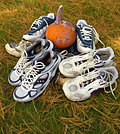Benefits of Exercise Walking
Walking improves cardiovascular fitness. As an aerobic exercise, walking gets the heart beating faster to transport oxygen-rich blood from the lungs to the muscles. The heart and lungs grow more efficient with a regular walking regimen, reducing blood pressure and the resting heart rate. Walking is even a central element of medical rehabilitation including cardiac rehabilitation programs.
For people with poor circulation to the arms and legs, walking can increase the size and improve the efficiency of the tiny vessels that supply blood for cellular respiration. Anyone diagnosed with poor circulation should see a doctor before beginning exercise walking.
Psychologically, walking generates an overall feeling of well-being, and can relieve depression, anxiety, and stress by producing endorphins, the body's natural tranquilizer. A brisk walk will relax you and stimulate your thinking.
If you are more than 40 years old and have any problems with weight, respiration, blood pressure, pulse rate, or cholesterol, check with your doctor before walking. The same goes for diabetics, smokers, or people with preexisting injuries or a family history of heart problems.
On Your Feet
However, there are specialty walking shoes that may work well for you. These tend to be slightly less cushioned, yet not as bulky, and lighter than running shoes.
Most important, whether you are wearing a walking or running shoe, is that it must feel stable to you. Either type of shoe is acceptable if it works well with your foot mechanics, providing cushioning and stability.
Shoes should always feel comfortable and fit well in the store. Don't cut corners on your shoe budget; buying shoes is the only real expenditure necessary for the sport, so treat your feet well. Visit the shoe store late in the afternoon, when your feet are slightly swollen (this is when you'll likely be walking, anyway).
Wear the same socks to the store that you will wear while walking. Try on at least four or five pairs of shoes. Put on and lace both shoes of each pair and walk around for a minute or two.
Remember that every shoe manufacturer uses a different basic shoe shape, or "last." Some lasts are shorter or longer than others of the same size; some fit a wide foot perfectly, while others are cut for a slimmer foot.
Before buying, check the shoe's quality with the vertical heel test. Place the shoe on the store's counter and make sure the heel is straight up when looking at it from the back. Is the midsole well-connected to the upper? Is the stitching complete? Check inside the shoe for any irregular bumps.
When the shoes are on your feet, the heel should be snug. If it slides in the store, it will slide while you are walking. You should be able to wiggle your toes in the shoe, and there should be one half to a full thumb's width between the end of the longest toe on your longer foot and the end of the shoe's toe box. Make sure your ankles don't roll in the shoes.
If you have bunions or other special considerations, consult your podiatrist about the best shoe for you. If you have prescription inserts, substitute your insert for the existing one (most shoes have a removable insole) to make sure it will fit properly, if possible.
Foot Care for Walking
Podiatrists warn that self-treatment of corns and calluses with over-the-counter remedies before starting to walk can do more harm than good. Maladies that cause discomfort such as bunions and hammertoes should be evaluated by a podiatric physician before you begin to walk for aerobic exercise.
If blisters develop, self-treatment by opening the blister with a sterilized needle and draining the fluid is acceptable. Do not remove the "roof" of the blister. Cover the treated blister with antibiotic ointment and a sterile dressing to guard against infection.
Hitting the Road
Take five deep breaths for each slow stretch, and hold the stretched muscle firm without bouncing. After every walk, stretch again to improve circulation and decrease buildup of lactic acid, the chemical byproduct that causes muscles to ache.
Setting appropriate goals is vital to a successful walking program. First, make walking a habit. Start slowly, with five or 10-minute walks three to five times a week. As walks get longer, their frequency can be adjusted.
Before you know it, you'll be making time for weekly walks wherever you are. But don't overdo it. Starting too quickly and getting injured or uncomfortably sore can sour you on the whole idea before it's had a chance to work its magic on your mind and body.
Start your walks slowly, and gradually work up to a brisk speed that will cover a mile in 15 minutes (that's four miles per hour). Measure a one-mile stretch, record your time, and see how you improve as the weeks go by.
To get significant benefits from walking, you must eventually be able to walk 30 minutes at a brisk pace without stopping. You may gradually build up your mileage to 40 - 60 minutes. Calculate your week's total walking time in minutes, then try to increase it by 10 percent each week. A starting regimen should involve walking at least four times per week, but never exceeding five times a week. Walking every day denies the body the rest time it needs to repair minor injuries, and could lead to more serious ones.
Based on a document produced in cooperation with the: American Podiatric Medical Association

